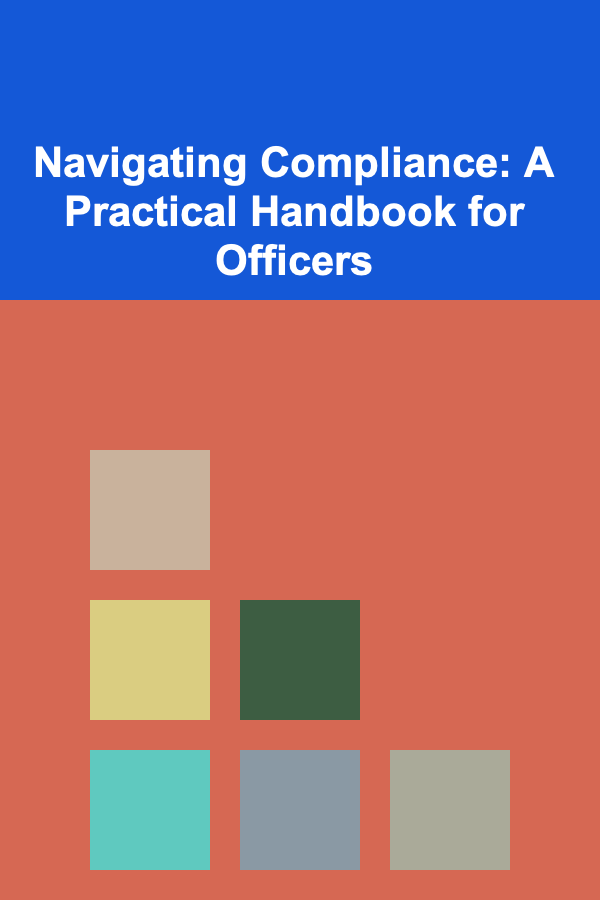
Navigating Compliance: A Practical Handbook for Officers
ebook include PDF & Audio bundle (Micro Guide)
$12.99$9.99
Limited Time Offer! Order within the next:

In today's increasingly regulated business environment, compliance officers are critical to ensuring that organizations operate within the law and adhere to ethical standards. Their role is more than simply ticking boxes or avoiding penalties; compliance officers are integral to the long-term success of a business. This practical guide aims to equip compliance officers with the knowledge, tools, and strategies needed to navigate the complexities of compliance and foster a culture of integrity within their organizations.
Understanding Compliance: More Than Just a Legal Requirement
Compliance, at its core, is about adhering to the rules, regulations, and standards set by external authorities and internal policies. However, effective compliance goes beyond mere legal conformity; it involves ensuring that the organization's practices align with both regulatory expectations and ethical principles. For compliance officers, this means balancing the need to avoid legal pitfalls with the imperative of creating an ethical and transparent organizational culture.
Key Components of Compliance
- Regulatory Compliance: Ensuring that the company adheres to laws, regulations, and industry standards, which could range from financial reporting requirements to environmental laws.
- Internal Policies and Procedures: These are the specific rules the organization sets for itself, beyond the legal requirements, and include ethical guidelines, code of conduct, and operational processes.
- Risk Management: Identifying, assessing, and mitigating risks that could affect the organization's compliance status or reputation.
- Training and Awareness: Promoting an understanding of compliance obligations across all levels of the organization.
Step 1: Building a Compliance Program from the Ground Up
Creating a comprehensive compliance program is the first step to ensuring that your organization stays compliant with legal and ethical requirements. A well-structured program serves as the foundation for ongoing monitoring, training, and risk management efforts.
Defining the Scope of the Compliance Program
The first task of a compliance officer is to understand the full scope of compliance within the organization. This involves mapping out the relevant regulations, industry standards, and best practices that apply to your business. The compliance program must be designed to cover all areas of the organization, including finance, human resources, operations, marketing, and IT.
Actionable Steps:
- Conduct a Compliance Risk Assessment: Start by identifying all relevant regulations that affect your industry. This might include data protection laws like GDPR, environmental regulations, financial compliance laws, or anti-bribery and anti-corruption rules. Additionally, evaluate internal risks such as employee misconduct, cybersecurity threats, or issues with third-party vendors.
- Develop Policies and Procedures: Once the key compliance areas are identified, draft clear, actionable policies that define acceptable practices, employee responsibilities, and reporting mechanisms. These policies should be tailored to address the unique needs of your industry and organization.
Establishing a Compliance Framework
A strong compliance framework will outline the organizational structure, policies, and systems required to monitor and enforce compliance. It should define key roles and responsibilities, detailing who is responsible for various aspects of compliance across the organization.
Actionable Steps:
- Appoint a Compliance Team: While the compliance officer leads the program, a team of compliance professionals should be assembled to support the effort. This team can include members from different departments to ensure broad organizational engagement.
- Set Clear Reporting Lines: Ensure there is clarity in reporting mechanisms, from frontline employees to senior management. Employees must feel comfortable reporting violations or concerns without fear of retaliation.
- Create an Oversight Structure: Designate a compliance committee that oversees the implementation of the program, audits compliance efforts, and addresses any issues that arise.
Step 2: Ongoing Monitoring and Auditing
A compliance program is not a one-time effort; it requires continuous oversight and periodic audits to ensure effectiveness. Monitoring helps identify potential compliance gaps, enabling the company to address issues proactively before they lead to significant risks.
Establishing Monitoring Procedures
Monitoring processes help identify any deviations from established compliance standards. This can be done through regular audits, system checks, and feedback loops.
Actionable Steps:
- Conduct Regular Audits: Set up a schedule for regular audits to assess how well the company is adhering to its compliance standards. Audits should cover financial transactions, operational procedures, and internal controls.
- Implement Key Performance Indicators (KPIs): Develop KPIs for compliance and track them over time. For example, you could track the number of compliance training sessions completed or the number of reported compliance violations to gauge how well the program is functioning.
Reporting and Transparency
It's crucial for employees to report compliance issues in a transparent and secure manner. A well-established reporting system helps the company identify problems early and take corrective actions.
Actionable Steps:
- Create a Whistleblower Program: Establish a confidential mechanism for employees to report violations of company policies, legal regulations, or ethical standards. This system must be designed to protect whistleblowers from retaliation.
- Use Technology for Monitoring: Consider implementing software solutions that can automate parts of the monitoring process, such as tracking financial transactions, monitoring employee activities, and flagging potential risks.
Step 3: Training and Cultivating a Compliance Culture
Training is vital to ensuring that employees are aware of their compliance obligations and understand how to make ethical decisions in their roles. An effective training program will empower employees to act in accordance with the company's ethical standards and regulatory obligations.
Designing a Comprehensive Training Program
Training should be an ongoing process, not just an initial one-time event. It should cover general compliance knowledge as well as specific issues related to the company's operations and industry.
Actionable Steps:
- Offer Mandatory Training Sessions: Develop a training program that is mandatory for all employees. This should cover the company's code of conduct, anti-bribery policies, cybersecurity awareness, and other relevant compliance topics.
- Tailor Training to Job Roles: Different departments may face unique challenges. Customize training for specific groups such as HR, finance, and legal teams, addressing the compliance challenges they are most likely to encounter.
- Use Engaging Formats: Use a variety of training formats such as online courses, in-person workshops, and scenario-based learning to make the material engaging and relevant.
Promoting Ethical Decision-Making
To truly embed compliance into the company culture, it must go beyond mere training. Employees should be encouraged to make ethical decisions in their everyday work and feel empowered to act in the best interest of the organization.
Actionable Steps:
- Create an Open Dialogue About Ethics: Foster an open environment where employees feel comfortable discussing ethical concerns and dilemmas. Encourage regular conversations about the importance of ethics in the workplace.
- Lead by Example: Senior leadership should set the tone for ethical behavior. When leaders demonstrate integrity and ethical decision-making, it encourages employees at all levels to do the same.
Step 4: Dealing with Compliance Violations and Ethical Dilemmas
Despite best efforts, violations and ethical dilemmas can still occur. It is essential to have a clear, systematic approach for addressing and resolving compliance breaches when they arise.
Investigating Compliance Violations
When a compliance violation occurs, it is critical to investigate promptly and thoroughly. An objective and fair investigation can help determine the root cause and prevent further violations.
Actionable Steps:
- Follow a Standard Investigation Process: Develop a step-by-step process for investigating suspected violations. This should include gathering evidence, interviewing witnesses, and documenting the investigation.
- Ensure Confidentiality: Ensure that the investigation process respects the privacy of individuals involved. This maintains trust in the compliance program and avoids unnecessary reputational damage.
Taking Corrective Action
Once the investigation is complete, corrective actions should be taken swiftly to address the issue and prevent future violations.
Actionable Steps:
- Implement Corrective Actions: Depending on the severity of the violation, actions could include disciplinary measures for individuals involved, revising policies or processes, or conducting additional training.
- Monitor Effectiveness of Corrective Actions: After corrective actions are implemented, it is important to monitor their effectiveness. This may involve additional audits or reviews to ensure that the violation does not recur.
Step 5: Staying Informed and Adapting to Change
Compliance officers must be proactive in staying informed about new laws, regulations, and industry best practices. The regulatory landscape is constantly evolving, and businesses must adapt to maintain compliance.
Keeping Up with Legal Changes
Regulations can change quickly, and staying ahead of these changes is crucial to maintaining compliance.
Actionable Steps:
- Subscribe to Industry News: Regularly read industry publications, attend conferences, and participate in webinars to stay updated on regulatory changes.
- Engage with Legal Advisors: Work closely with legal counsel to interpret new regulations and incorporate them into the company's compliance program.
Adapting to Emerging Risks
As businesses evolve and new technologies emerge, new compliance risks arise. Compliance officers must be agile and adaptable in responding to these risks.
Actionable Steps:
- Monitor Emerging Risks: Stay informed about new risks, such as those arising from technological advancements (e.g., AI, data privacy) or changes in global trade.
- Update the Compliance Program Regularly: Continuously review and update the compliance program to address new risks and ensure it remains relevant and effective.
Conclusion
Compliance is an ongoing process, not a one-time checklist. By building a solid compliance framework, maintaining continuous oversight, providing effective training, and addressing violations transparently, compliance officers can ensure that their organizations not only meet legal requirements but also foster an ethical and transparent culture.
In an era of increasing regulatory scrutiny and ethical challenges, compliance officers must be proactive, adaptable, and committed to promoting a culture of integrity. Through careful planning, strategic action, and continuous learning, compliance officers can help steer their organizations toward long-term success and sustainability.

How to Build a Networking Strategy for Your Workshop
Read More
How to Create a Checklist for Designing Mobile-Friendly Emails
Read More
How to Find the Best Home Depot Artificial Christmas Trees Pre Lit
Read More
How to Learn from Professional Cleaners: Tips and Techniques
Read More
How to Make Money Online as a Pinterest Strategist: 10 Actionable Ideas
Read More
How to Reorganize Your Living Room After a Move
Read MoreOther Products

How to Build a Networking Strategy for Your Workshop
Read More
How to Create a Checklist for Designing Mobile-Friendly Emails
Read More
How to Find the Best Home Depot Artificial Christmas Trees Pre Lit
Read More
How to Learn from Professional Cleaners: Tips and Techniques
Read More
How to Make Money Online as a Pinterest Strategist: 10 Actionable Ideas
Read More